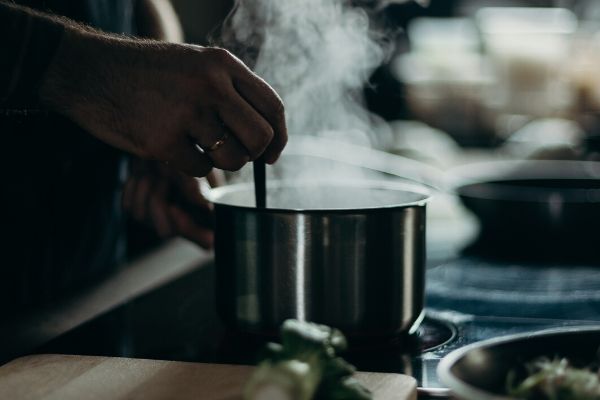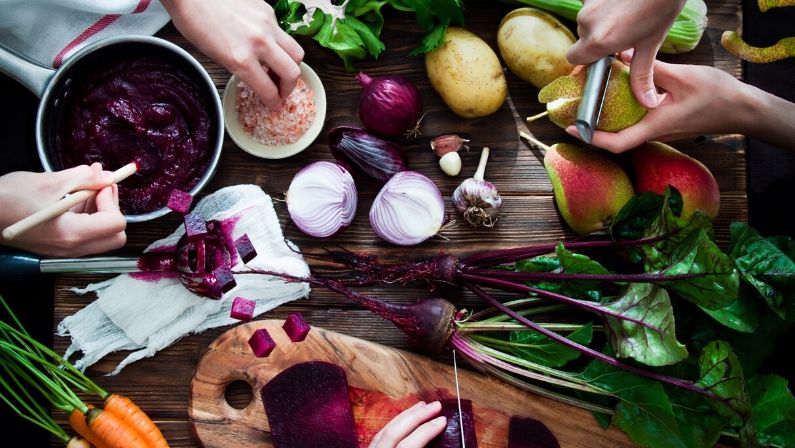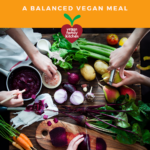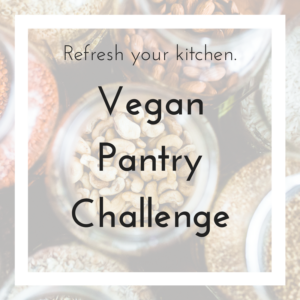It’s 6:34 p.m. and you just got home. You are hungry. Maybe you had planned something based on a new recipe, but you do not feel the energy to follow through. You don’t have a prepared meal ready to reheat and gobble up. The temptation to pick up the phone and order something comforting from your favorite restaurant is high. But… wait! You know that, although tasty, the delivery option will likely be expensive, wasteful, and not-so-healthy. You can do better at home – and it might even be faster. In this post, I will show you the simple steps to improvise a balanced vegan meal from pantry ingredients (even when you are too exhausted to cook). You can do this! Once you have taken the first step, you’ll build up the momentum to keep on cooking.
First step: pull out a knife and cutting board
A common piece of advice for those who need a nudge to get on with an exercise program is to go to sleep with their gym clothes on. When you wake up, you are already committed to starting your workout. The same is true when you need to commit to cooking: setting your cutting board on the counter and pulling out your favorite knife will get your cooking gears turning. Once those are out, wouldn’t you feel ridiculous picking up the phone to order pizza?
If there is even the slightest chance that you’ll be roasting anything, fire up the oven right away at 350 degrees Fahrenheit. If you change your mind, you can just turn it off.
Real first step: pick your produce
Whether they are meal planning or improvising dinner, many omnivorous cooks often start by asking themselves: “what protein do I have in the fridge?” By that, they mean: meat. I get it: meat can be expensive, and it spoils quickly. When we start cooking plant-based meals, many of us carry that old habit over with us. We compose meals by asking ourselves what kind of protein-dense food we’ll put at the center of the dish. “Tofu, beans, peas, seitan, or some kind of vegan meat?” That tends to be our starting point. Our meal planning process is driven by our undue obsession with protein. Even if we know that plants have protein, we can’t shake our old pattern.
Let’s flip that mindset over. The most precious food in a kitchen is the produce. Packed with micro- and macro-nutrients alike (including, yes, protein), colorful vegetables deserve the center stage of our meals. In fact, the new Canadian Food Guide recommends that half the plate be occupied by vegetables – and it doesn’t mean potatoes! To increase your odds of hitting the mark when you improvise a meal, start by pulling from your refrigerator any and all fresh vegetables that are either past their prime (but still edible!) or at their peak freshness. Cooked vegetables leftover from previous meals count, too.
If you do not have fresh or cooked veggies, look for a bag of frozen ones next. Failing that, look for canned vegetables.
Getting started was the hardest part. Put your findings on the counter and move to step two.
Second step: choose the best-suited mode of preparation
Did you find crisp vegetables that will be best enjoyed raw (salad) or benefit from a quick meeting with high heat (stir-fry)? Or did you dig out hard vegetables like roots or squashes that will best release their sugars in a simmered or roasted dish? Perhaps all you have is slightly wilted produce or long-frozen vegetables that will modestly support a soup stew? Let whatever you found dictate your next steps, keeping in mind the urgency of your hunger. If you are already starving, roasting that head of cauliflower whole might not be the best strategy… but a quick chop into florets will work.
If you have a good blender, keep in mind that many veggies also make a scrumptious sauce. Leftover cooked beets blended with some nuts (for creaminess) make an eye-popping hot pink pasta sauce. Cooked yam (orange sweet potato), blended with a handful of nuts or seeds plus nutritional yeast, turns into a ridiculously healthy cheesy sauce – way better than anything you can get in a box (even the vegan version). If you found lots of wilting herbs in the produce drawer, you got yourself the base for pesto.
Third step: recruit supporting actors
Vegetables are the prima donnas of vegan dinners, but without protein-dense foods and (whole) grain ingredients, their show will leave you hungry for more.
Protein-rich foods
Beans, chickpeas, lentils, tofu, and vegan meats, will combine just fine with any vegetable. But, if you have a choice, you’ll want to pick your cast based on the mode of preparation chosen above. Your goal is to keep it quick and to avoid making too many dishes dirty.
If you’re making a stir-fry, tofu and many meat analogs can be cooked in the same skillet as the veggies. I recommend sautéing them first, then setting them aside, sautéing the rest of the ingredients and adding the protein back in at the end, letting it all warm up for 2 minutes before serving.
If you are roasting things, then chickpeas spread on a baking sheet (perhaps tossed in a teaspoon of oil…) will add a great contrast of texture to your meal. Chances are, they’ll be lovely to eat at the same time as the veggies. Lentils are best in soups and stews, although firmer ones (French “de Puy” green lentils and black beluga lentils) make great additions to salads, cooking while you’re chopping the rest of the ingredients.
Make your protein choice and put the selected ingredient on the counter with the veggies.
Grains
For grains, I know pasta is an appealing option and I often reach for that, too, when I’m not in the mood for cooking. But remember that you can cook practically all other grains (and pseudo-grains like quinoa) the same way: bring a pot of water to a boil, add the grains, and cook for 10-15 minutes, stirring regularly, tasting for doneness. Measuring isn’t a requirement! When al dente, quickly drain through a fine-mesh sieve and return to the hot pot, covered, but off the heat. In 10 minutes, fluff with a fork and you’ll be done.
Brown rice does take longer to cook, but red rice is faster, and quinoa will be done in about 15 minutes. Couscous is practically instant (even if unlike the others it does require measuring).
Set the container of grains on the counter with the veggies and protein foods. The hardest part is behind you.

Fourth step: start two fires…
Popular bloggers promise “one pot meals,” and it does work in a limited number of cases (especially if you have prepped one of the meal components already). But the truth of most dinners is that they are most often cooked in two pots: one pot for the grains, and a second pot (or skillet) for the rest. Another option is to cook the grains in one pot and to roast the rest. Or to throw the veggies to boil in the pot with the grains while using a skillet to enhance the texture of the protein. Whichever way you go, you’ll need two hot elements. Unless you are making soup, in which case you can pull it off in one pot… although if using noodles I like to cook those separately. But sometimes I just can’t be bothered and that’s OK too.
Get your pots and/or oven going, then pause for a moment while they heat up. Now look at what you have gathered on the counter. Close your eyes (just for 10 seconds!) and imagine what the finished dish will look like. Keep it simple.
Then decide of the order in which things will be added to the heat. Denser ingredients take longer to cook, so make sure those get started as soon as possible. You don’t need to know exactly what your plate will look like to get the yam halves started in the oven: you’ll have plenty of time to think through details while they roast.
… unless you are making a raw salad.
I personally prefer my salads to have a cooked grain in them so I can feel really satiated, but if raw is your thing you may want to add spiralized root vegetables for the same purpose. Another option is to serve your big bowl of chopped and/or grated veggies with reasonably-healthy whole-grain crackers (like Wasa bread) or slices from a nice loaf of bread. In those cases, you won’t need the fires.
Start cooking
Just because you aren’t following a recipe doesn’t mean you don’t know what you are doing. If you have been cooking for yourself for more than a few months, you probably know a lot more than you think! You (roughly) know how to make a stir-fry, or soup, or stew, or fried rice, or bowl. Just keep on cooking and trust yourself. Nothing really bad can happen… as long as you keep the heat (from the stove and from chili peppers) and salt in check.
Your hands know what to do. Give them a chance to prepare the meal for you.
Finally: add flavor and nutrition boosters
Let’s keep expectations in check: this is an improvised meal that you’ve hacked together at the last minute, without a plan, instead of ordering pizza. Whatever you do, it will be better for your health, for your pocketbook, and for the planet, than the alternative. If you can add a finishing touch to your meal, it will probably make it better for your palate, too! Here are some ideas to improve your creation:
- Add spices. Curry powder, taco seasoning, and other mixes you may have can be sprinkled into your veggies as you cook them to add flair. Individual spices like cumin and smoked paprika are good on good on (almost!) everything. Add a little, taste, and add more if desired.
- Don’t shy away from garlic and ginger. Those two are flavor bombs that also fight all the bad stuff in your body. Chop finely and add in the last minute of cooking the vegetables, just before you add any liquid.
- Don’t forget salt and pepper! If you are used to eating restaurant food a lot, you are most likely habituated to large amounts of sodium. It can completely change the experience of a dish! I certainly don’t recommend that you try to reproduce that at home, but know that your food will probably taste really bland to you if you don’t put any at all. Add a bit of salt during cooking, taste, and adjust seasoning. If you keep up the good habit of cooking at home, you can progressively lower the amount of sodium you consume.
- Scour your fridge and pantry for forgotten condiments that can take your dish to the next level. Kalamata olives enhance the roasted vegetables from any Mediterranean dish. A spoonful of chutney will raise your curry’s profile. What about a forkful of kimchi on that stir-fried broccoli?
Eat mindfully
Congratulations! The time has come to enjoy the fruit of your labor. Enjoy your dinner. As you eat, pay attention to what’s in front of you and how it feels in your mouth. Ask yourself what you like about it, and think about what you’d do differently next time. That’s the best way to improve your improvisation cooking skills.
Bon appétit!





This was an extremely helpful and awesome post! I am trying to eat more vegan meals but have a family of meat eaters and struggle to think of things to make. Thank you!
Thanks Jose for your kind words and thanks also for trying to eat more plants – and feeding them to others. I know it can be a challenge, but have faith: based on my own (no-exactly-scientific) research, eventually they all come around, even if it takes a couple of years. It’s a good investment of your efforts!
Great post Brigette. I will share it with my WFPB group here on Mayne, Stay well.
Thanks for sharing the plant love!
Thanks you Allen for passing this on. Thank your Brigette. I enjoyed this very much. Ha ve signed up for your seven days of menus.
Fantastic, Maureen! Let me know how it goes.
Thanks for the really good post, especially for the novice, the lazy, or the bored!
Thanks Dan!